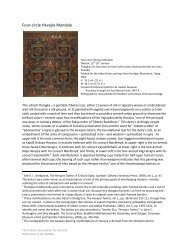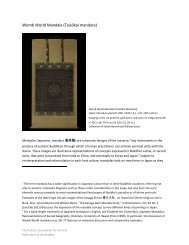Reflections of the Buddha - The Pulitzer Foundation for the Arts
Reflections of the Buddha - The Pulitzer Foundation for the Arts
Reflections of the Buddha - The Pulitzer Foundation for the Arts
You also want an ePaper? Increase the reach of your titles
YUMPU automatically turns print PDFs into web optimized ePapers that Google loves.
Lower Gallery<br />
23. Buddhist Triad: <strong>Buddha</strong> Amitābha (Amita Yeorae)<br />
Seated on a Lotus Throne with His<br />
Hands Held in <strong>the</strong> Bhūmisparśa<br />
mudrā (chokji in) and Flanked by<br />
Two Standing Bodhisattvas,<br />
Presumably Avalokiteśvara<br />
(Gwaneum) and<br />
Mahāsthāmaprāpta (Daeseji),<br />
mid-15th century<br />
Korea, Joseon dynasty, 1392 – 1910; gilt silver; 4¼ x 4 x 2� in.;<br />
Harvard Art Museums / Arthur M. Sackler Museum, Gift <strong>of</strong> Ralph<br />
C. Marcove, M.D., 1997.254<br />
<strong>The</strong> central figure <strong>of</strong> this rare silver-cast triad was long<br />
thought to depict Śākyamuni extending a hand downward,<br />
“calling <strong>the</strong> earth to witness at <strong>the</strong> moment <strong>of</strong><br />
enlightenment.” It is now believed to be Amitābha with<br />
a striking array <strong>of</strong> curls and high usnīsa. Two standing<br />
bodhisattvas, who likely signify Amitābha’s wisdom and<br />
compassion, respectively, flank him. <strong>The</strong> work was<br />
probably produced in <strong>the</strong> area around Mt. Geumgang<br />
in North Korea and commissioned by a confraternity<br />
during a time when Buddhism, because it was <strong>of</strong>ficially<br />
denounced by <strong>the</strong> state, developed at a popular level<br />
independent <strong>of</strong> elite clerics and canonical texts.<br />
45<br />
24. “<strong>The</strong> Universal Gateway <strong>of</strong> Bodhisattva<br />
Avalokiteśvara,” Chapter<br />
Twenty-Five <strong>of</strong> <strong>the</strong> Lotus<br />
Sūtra (Mia<strong>of</strong>a lianhua jing<br />
Guanshiyin pusa pumenpin),<br />
with an appended<br />
Heart Sūtra (Xin jing), 1432<br />
China, Ming dynasty, 1368 –<br />
1644; accordion-fold book; gold ink on indigo-dyed paper; palace<br />
copy; overall: approximately 13⅜ x 542⅜ in.; Harvard Art<br />
Museums / Arthur M. Sackler Museum, Gift <strong>of</strong> Alan Priest, 1926.46<br />
This manuscript contains <strong>the</strong> texts <strong>of</strong> two <strong>of</strong> <strong>the</strong> most<br />
popular sūtras (sacred texts) in Mahāyāna Buddhism:<br />
<strong>the</strong> twenty-fifth chapter <strong>of</strong> <strong>the</strong> Lotus Sūtra and <strong>the</strong> Heart<br />
Sūtra. Both present Avalokiteśvara, known in China as <strong>the</strong><br />
Guanyin. <strong>The</strong> first text vividly describes <strong>the</strong> myriad calamities<br />
from which Guanyin will save any worshipper<br />
who cries out his name, and <strong>the</strong> diverse <strong>for</strong>ms that he<br />
can take in order to make <strong>the</strong> <strong>Buddha</strong>’s teachings understood<br />
to any aspiring believer. By contrast, <strong>the</strong> Heart Sūtra<br />
presents a less worldly and more philosophically engaged<br />
Guanyin. <strong>The</strong> text uses his voice to present an abbreviated<br />
explanation <strong>of</strong> <strong>the</strong> <strong>Buddha</strong>’s teachings, emphasizing in<br />
particular <strong>the</strong> non-dual nature <strong>of</strong> emptiness and <strong>for</strong>m,<br />
and <strong>the</strong> understanding that all things arise dependently.<br />
<strong>The</strong> indigo dye used to color <strong>the</strong> paper served both a<br />
practical and a symbolic purpose—deterring insects from<br />
eating away at <strong>the</strong> paper and evoking lapis lazuli, which<br />
is mentioned repeatedly in <strong>the</strong> Lotus Sūtra, including in<br />
this passage: “<strong>Buddha</strong> lands, adorned with numerous<br />
jewels, shone with hues <strong>of</strong> lapis lazuli and crystal ... due<br />
to <strong>the</strong> illumination <strong>of</strong> <strong>the</strong> <strong>Buddha</strong>’s light.”<br />
Note: Periodically throughout <strong>the</strong> exhibition, <strong>the</strong> <strong>Pulitzer</strong> will put<br />
different sections <strong>of</strong> <strong>the</strong> Lotus Sūtra on view.




